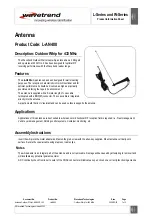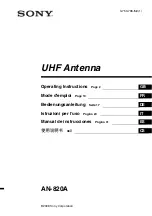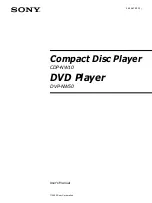
9497B-21 C/Ku-Band TVRO
Basic System Information
3-3
operations of the antenna. The actual elevation pointing angle to the satellite is determined by your latitude
& longitude and the longitude of the satellite. In general terms the elevation angle will be low when you are
at a high latitudes and will increase as you get closer to the equator.
Additionally, from any given latitude, the elevation will be highest when the satellite is at the same longitude
that you are on. If the satellite is east, or west, of your longitude the elevation angle will be lower.
3.2.3.
The scalar section of the feed is fitted with a polarization motor and a potentiometer for position feedback
required for linear signal operation. The feed may be fitted for Linear or Circular reception. The appropriate
LNA, LNB or LNC must be installed on the Linear or Circular section of the feed to receive the frequencies of
the desired satellite.
Feed Assembly
When a Linear feed is installed, the ACU automatically adjusts the feed by remotely controlling the 24 volt
DC motor, using the potentiometer feedback for Linear polarization position (Auto-Polarization mode).
When a Circular feed is installed, no polarization adjustment is required because the circular feed receives the
signal properly regardless of its polarization position.
The feed may be dual band (C-Band and Ku-Band) allowing you to use either band. The Tracking - Band
Selection remotely controls coax switches mounted on the antenna pedestal to select which LNB outputs are
routed through the antenna pedestal to the Below Decks Equipment.
3.2.4.
You have a linear polarization feed installed, the system should have been adjusted properly and set-up to
operate in Auto-Polarization mode. The ACU will then automatically adjust the polarization of the feed, as
necessary, while the ship travels in Latitude and Longitude.
Antenna polarization
3.2.5.
Your antenna is stabilized in all three axes of motion. Stabilization is the process of de-coupling the ships’
motion from the antenna. Simply put, this allows the antenna to remain pointed at a point in space while the
boat turns, rolls or pitches under it. To accomplish this, the Pedestal Control Unit (PCU) on the antenna
pedestal assembly senses the motion and applies drive to the appropriate motor(s) in opposition to the
sensed motion. Azimuth (AZ), Elevation (EL) and Cross-Level (left-right tilt) are actively stabilized
automatically by the PCU as part of its normal operation.
Stabilization
3.2.6.
Whenever the desired satellite signal is lost (such as when the antenna is blocked) the Antenna Control Unit
will automatically initiated a Search to re-acquire the desired signal.
Search Pattern
Search is conducted in a two-axis pattern consisting of alternate movements in azimuth and elevation. The
size and direction of the movements are increased and reversed every other time resulting in an expanding
square pattern.
When the antenna is able to re-acquire the desired signal the ACU will automatically stop searching and begin
Tracking the signal to optimize the pointing of the antenna to get the highest signal level from the satellite.
3.2.7.
The Satellite Identification Receiver located in the Antenna Control Unit (ACU) is used to acquire, identify
and track a specific satellite by its unique hexadecimal ID code. When properly setup, the settings for the
satellite are saved to expedite future acquisition of the desired satellite.
Tracking Receiver - Satellite Identification Receiver
When searching for the selected satellite this receiver compares the present satellite ID to the targeted
satellite ID code. If the ID code does not match the antenna will continue searching until the correct satellite
is found. The system must have adequate satellite signal level, AND the matching NID, to stop searching (and
begin tracking the desired satellite).
3.2.8.
Your Antenna Control Unit actively optimizes the pointing of the dish for maximum signal reception. This
process is called
tracking
and is accomplished by continuously making small movements of the dish while
monitoring the level of the received signal. Evaluation of this information is used to continuously move the
stabilization point toward peak satellite signal reception. These minor pointing corrections keep the signal
level “peaked” as part of normal operation.
Tracking
Содержание 9497B-21
Страница 3: ......
Страница 4: ...iv Revision History REV ECO Date Description By A N A August 17 2010 Initial Production Release MDN ...
Страница 40: ...Setup 9497B 21 C Ku Band TVRO 5 4 This Page Intentionally Left Blank ...
Страница 70: ...Maintenance and Troubleshooting 9497B 21 C Ku Band TVRO 7 28 This Page Intentionally Left Blank ...
Страница 76: ...9497B 21 Technical Specifications 9497B 21 C Ku Band TVRO 8 6 This Page Intentionally Left Blank ...
Страница 78: ...Model 9497B 21 Drawings 9497B 21 C Ku Band TVRO 9 2 This Page Intentionally Left Blank ...
Страница 80: ......
Страница 83: ......
Страница 86: ......
Страница 88: ......
Страница 90: ......
Страница 97: ......
Страница 98: ......
Страница 102: ......
















































